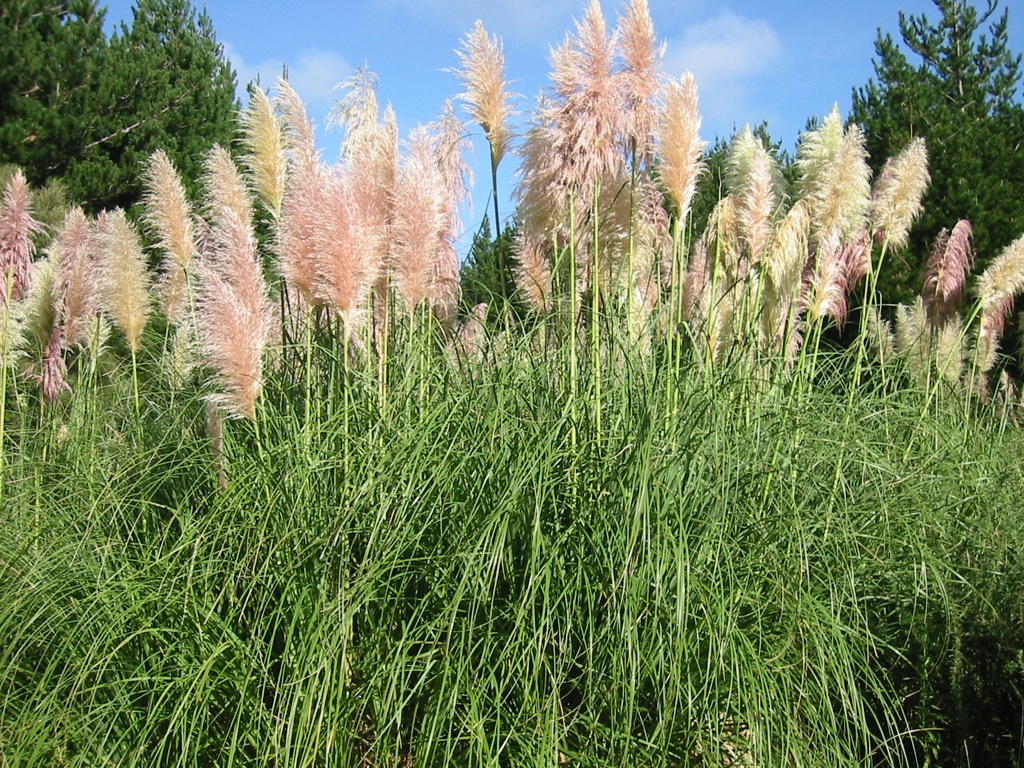Plants pistillate (in North America). Culms 2-7 m, 4-7 times as long as the panicles. Leaves primarily basal; sheaths hairy, sometimes densely so; ligules 1-2 mm; blades 1 m long or longer, 2-10 cm wide, mostly flat, often horizontal, dark green, abaxial surfaces hairy near the base. Panicles 30-100 cm, elevated well above the basal foliage, deep violet when young. Spikelets 14-16 mm, pistillate; florets readily disarticulating; calluses about 0.6 mm; lemmas about 10 mm, long-attenuate to an awn, awns to 1 mm; paleas to 4 mm, keels ciliate, apical hairs extending beyond the body of the paleas; stigmas usually not exserted. Caryopses to 2.5 mm; embryos to 1 mm. 2n = 108.
Cortaderia jubata is found on the west coast of the coterminus United States, growing in disturbed, open ground such as brushy slopes, eroded banks and cliffs, road cuts, cut-over timber areas, and sand dunes. It is native to mountainous areas of Bolivia, Peru, and Ecuador. It was grown in the past as an ornamental because of its attractive panicles, but is now a serious weed in California, reproducing apomictically and invading many open habitats. It was mistakenly called Cortaderia rudiuscula Stapf by Hitchcock (1951). The florets of C. rudiuscula differ from those of C. jubata in being longer and narrower, having shorter, less hairy calluses, and in having no hairs that extend beyond the top of the palea. Cortaderia rudiuscula is not known from North America.
Common Name: purple pampas grass
Duration: Perennial
Nativity: Non-Native
Lifeform: Graminoid
General: Large introduced bunchgrass with sharp-edged leaves and a large plume-like inflorescence. Can reach heights of 7 meters. Plants pistillate (female).
Inflorescence: Panicles well above the foliage, 30-100 cm long, violet when young, then becoming brown; spikelets 1.5 cm, pistillate; lemmas 1 cm long, attenuating to an awn 1 mm long; paleas to 4 mm long, with ciliated keels and apical hairs that extend beyond the palea body; caryopses to 2.5 mm.
Ecology: Found on disturbed sites such as along roadways, timbered areas, brushy slopes, sand dunes, and coastal areas at up to 2600 ft. (800 m).
Distribution: Found in California, Oregon, and Hawaii but is native to Bolivia, Peru, and Ecuador. (FNA)
Notes: Native to the Andes; is now considered an invasive especially in coastal areas. Is similar to C. rudiuscula, but C. rudiuscula is diffentiated by its longer and narrower shape, its shorter, less hairy calluses, and by not having hairs that extend beyond its paleas.
Etymology: Cortaderia is from cortadera, an Argentinian Spanish word for cutting, while jubata means crested, with long awns.
Editor: LKearsley, 2012








